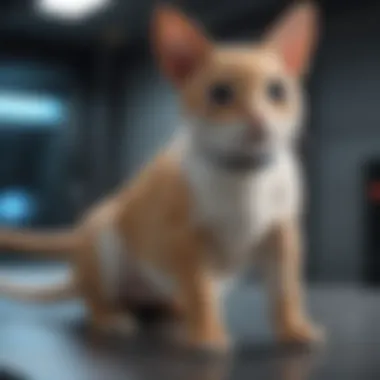The Evolution of Ito Pets: Technology and Companionship


Intro
As technology advances, the concept of companionship is also evolving. Ito Pets emerge as an intriguing phenomenon, merging artificial intelligence with our innate desire for connection. This article will explore the formation of Ito Pets, their transformations over historical periods, and their contemporary societal relevance.
Key Findings
Major Results
The research into Ito Pets reveals significant trends and patterns. Various studies showcase how these digital companions can reduce loneliness and enhance emotional well-being. This is particularly true for vulnerable populations such as the elderly or those with social anxieties. Furthermore, the data indicates that technology-based companionship offers unique benefits, like tailored interactions that adapt to individual user needs.
Research also suggests a growing acceptance of Ito Pets within society. Surveys indicate that many people perceive these digital entities as legitimate companions. The convenience and flexibility of Ito Pets present a compelling alternative to traditional pets, presenting various affordances. Their ability to engage and evolve with users makes them an attractive option in an increasingly busy world.
Discussion of Findings
The findings from these studies highlight essential implications regarding our relationship with technology. As we rely more on digital interactions, it is vital to consider how Ito Pets may influence our social dynamics.
Key discussions include:
- The blend of technology into daily life, blurring the lines between real and artificial companionship.
- Ethical considerations involving ownership, attachment, and emotional investment in these pets.
- Psychological implications of prolonged interaction with Ito Pets, particularly concerning attachment theory and its sociocultural aspects.
"Ito Pets can transform interactions by providing companionship in a way that mimics human relationships but poses new ethical questions."
Methodology
Research Design
The examination of Ito Pets relies on a mixed-method approach. This includes both qualitative interviews and quantitative surveys that gauge public perception and experience. This design allows for rich, contextual insights while maintaining statistical validity.
Data Collection Methods
Data collection involves several strategies. Researchers have conducted surveys on various platforms, gathering responses from platforms like Facebook and Reddit. This enables a diverse demographic, ensuring the representation of various age groups and backgrounds.
In-depth interviews with users provided qualitative insights, illuminating personal experiences with Ito Pets. These methodologies combine to furnish a holistic view of the impact and evolution of Ito Pets, aligning with the article’s objective to raise awareness and understanding of this technological shift.
Foreword to Ito Pets
The concept of Ito Pets encapsulates the intersection of companionship and technology, a growing phenomenon that reflects contemporary social dynamics. Understanding Ito Pets is essential for grasping how our relationships with digital entities evolve. As virtual and robotic companions have gained prominence, they challenge traditional notions of companionship and emotional attachment. This article aims to explore these themes in depth while shedding light on the significance of Ito Pets in modern life.
Defining Ito Pets
Ito Pets are digital or robotic companions designed to simulate interaction and emotional engagement. They can range from simple virtual pets, like Tamagotchi, to complex AI-driven robotic creatures. While the primary function of these pets is to provide companionship, their utility extends beyond mere entertainment. Users often report emotional support from these entities, highlighting the unique bond formed between humans and their Ito Pets.
Such relationships call for a deeper exploration of what it means to be a pet owner in a digital landscape. A good definition of Ito Pets emphasizes their role as empathetic companions, capable of responding to user emotions and needs.
Historical Context of Digital Companionship
Digital companionship is not a new concept. Its roots can be traced back to the late 20th century with the advent of simple computer games and virtual pets. The launch of Tamagotchi in the 1990s marked a turning point, introducing many people to the notion of caring for a digital being.
As technology advanced, so did the complexity of these companions. The introduction of social media allowed users to share experiences related to their Ito Pets, creating communities around these virtual entities. This historical progression illustrates how digital companionship evolved alongside technological innovations, ultimately leading to more sophisticated forms of interaction in today�’s landscape.
In summary, the growth of Ito Pets reflects broader societal changes, with implications that resonate in our everyday lives. By understanding their definition and historical context, one can appreciate the deeper impact that Ito Pets have on human emotions and relationships.
The Diversity of Ito Pets
The exploration of Ito Pets showcases a significant spectrum of digital companionships that resonate with various user needs and preferences. Their increasing popularity reflects upon how technology-mediated interactions have evolved to cater to emotional, therapeutic, and social requirements. Understanding this diversity helps in appreciating the broader implications of Ito Pets in our daily lives and their role within society.
Categories of Ito Pets


Virtual Pets
Virtual pets have gained prominence as engaging digital companions. They allow users to care for and interact with a pet simulation, often in a gamified environment. The key characteristic of virtual pets is their versatility; they can take many forms, from simplistic 2D animations to more sophisticated 3D graphics.
The unique feature of virtual pets lies in their accessibility. Unlike traditional pets, they require no physical space, feeding, or walking, making them a popular choice for people with limited time or resources. However, this ease of use can lead to a lack of genuine emotional attachment compared to real animals.
Pros of virtual pets include:
- Accessibility: They are easy to acquire and maintain.
- Emotional Relief: Users often find comfort in caring for their virtual companions.
Cons include:
- Limited Interaction Depth: Interactions with virtual pets can feel superficial.
- Possible Detachment: Users might become overly reliant on virtual experiences, neglecting real-life connections.
Robotic Companions
Robotic companions represent a tangible extension of digital companionships. These are physical machines designed to provide comfort, companionship, or assistance to users. A notable characteristic of robotic companions is their ability to mimic real-life behaviors and emotions, providing an illusion of sentience.
Their unique feature is the integration of robotics with artificial intelligence, allowing for interactions that can evolve over time based on user feedback. This is particularly appealing for elderly individuals or those requiring companionship.
Advantages include:
- Realistic Interaction: Provides a more lifelike experience compared to virtual pets.
- Usage in Therapy: Can be employed in therapeutic settings, offering emotional support.
Disadvantages are:
- High Cost: They often require significant financial investment.
- Technical Issues: Like any technology, they may face malfunctions or software updates that disrupt their functionality.
AI-Based Interactions
AI-based interactions elevate the concept of companionship to a new level. Here, the core of the experience is grounded in sophisticated algorithms enabling real-time responses and personalized experiences. The hallmark of AI companionship is adaptability; these systems learn from interactions and can tailor their responses according to user preferences.
One unique feature is the ability to provide companionship that feels increasingly intelligent and intuitive. The immersive options for conversation or interaction significantly enhance user experience and satisfaction.
Benefits of AI-based interactions include:
- Personalization: Continuous learning allows for tailored interactions.
- Emotional Support: Can provide valuable support in mental health contexts.
However, challenges exist:
- Dependence on Technology: Users might become overly reliant on AI for companionship.
- Privacy Issues: Concerns about the data privacy of users' conversations and preferences can arise.
Cultural Variations across Regions
The diversity of Ito Pets is not limited to their categories. It also spans across cultural contexts, reflecting regional preferences and societal values. In some regions, virtual pets might dominate, while in others, robotic companions could be seen as more desirable due to local technological advancements.
Understanding these cultural variations is critical to grasping how digital companionship affects relationships at every level. The significance of Ito Pets hence lies in their capability to adapt and resonate with different social norms while continuing to evolve as part of the digital era.
Technological Developments Driving Ito Pets
The advances in technology are central to the evolution of Ito Pets. These developments have shaped their characteristics and capabilities, making them more lifelike and relatable. Understanding the role of technology is crucial for grasping the impact of these virtual companions on society.
Advancements in Artificial Intelligence
Artificial Intelligence (AI) is a primary driver of Ito Pet functionality. The integration of AI makes these pets interactive and responsive. For example, AI algorithms allow virtual pets to learn from their owner's behavior. They can simulate emotional responses and adapt to human moods. This advancement creates a more immersive experience for users, fostering a stronger bond between humans and their digital counterparts.
The sophistication of AI enhances communication between users and pets. Users can engage with AI-driven pets through voice commands or programmed behaviors. As technology continues to evolve, the potential for more advanced AI integrates increasingly natural interactions. This shift not only captures user attention but also raises questions regarding the emotional investment people place in these digital beings.
Impact of Robotics on Companion Animals


The field of robotics also significantly influences the Ito Pets landscape. Robotic companions present a physical embodiment of pet ownership without the demands of traditional animals. Devices like Sony's Aibo demonstrate how technology can replicate pet behavior, offering both companionship and entertainment. Robotics innovation has generated a new type of pet that is reliable and interactive, meeting various emotional needs.
Unlike their digital counterparts, robotic pets have a tangible presence. This physicality contributes to the development of more meaningful interactions. Users can touch, hold, and engage with robotic pets in ways that digital counterparts cannot provide. Over time, this personal connection may help alleviate feelings of loneliness and isolation.
Augmented Reality in Pet Simulation
Augmented Reality (AR) pushes the boundaries of how users interact with Ito Pets. AR technology allows users to visualize and engage with their digital pets in real-world environments. Applications such as Pokemon Go have shown how AR can blend reality and imagination. This immersive technology adds a layer of richness to the user's experience with Ito Pets.
Through AR, pets can appear to play in the living room or accompany their owners on walks. This creates a richer narrative and encourages engagement in everyday activities. It also promotes social interaction, as users can share AR experiences with friends. However, as AR becomes more integrated into Ito Pets, it invites discussion about the balance between real and virtual interactions.
The development of technology for Ito Pets significantly alters perceptions of companionship, reshaping our understanding of emotional connections in a digital age.
In summary, the technological developments driving Ito Pets foster a unique connection between humans and their digital companions. Advancements in AI, robotics, and AR contribute to enhancing user experience and broadening the definition of companionship. As we move forward, these innovations will continue to influence our relationship with both virtual and robotic pets.
Psychological Impacts of Ito Pets
The psychological impacts of Ito Pets are an essential aspect of understanding their significance in our lives. As technology advances, the presence of digital companions can influence our mental well-being in various ways. This section explores the specific elements that underline the therapeutic benefits and stress reduction effects associated with Ito Pets, offering deeper insights into their role in contemporary society.
Therapeutic Benefits of Digital Companionship
Digital companionship through Ito Pets serves numerous therapeutic purposes. Research indicates that interacting with virtual or robotic pets can foster emotional growth and development. For many individuals, especially those who experience loneliness or social anxiety, these pets provide a sense of companionship without the complexities inherent to human relationships.
The therapeutic benefits can include:
- Emotional Support: Ito Pets can mimic emotional responses, allowing users to feel understood. This support can be crucial for individuals coping with depression or anxiety.
- Social Skills Development: Engaging with digital pets can enhance social skills. This interaction creates low-pressure environments for users to practice communication and empathy.
- Cognitive Engagement: Many Ito Pets require owners to engage in problem-solving or creative thinking. This mental stimulation can be beneficial for cognitive health.
In essence, Ito Pets possess the ability to provide comfort and emotional validation. They serve a function somewhat akin to therapy animals, where the therapeutic presence is leveraged via technology.
The Role of Ito Pets in Stress Reduction
Ito Pets also play a vital role in stress reduction. Their nature allows users to engage without the expectations or demands that often come with real-life pets. Interactions with these digital companions can lead to a release of oxytocin, often referred to as the 'love hormone.' Such biochemical reactions contribute to decreased stress levels and an overall sense of calmness.
The stress reduction effects can be summarized by the following points:
- Reduced Responsibility: Unlike traditional pets, Ito Pets do not require constant maintenance. Users can enjoy the benefits of companionship without the burdens of care.
- Immediate Availability: Ito Pets are always accessible. During moments of anxiety or stress, users can engage with their companions at any time, providing direct access to comfort.
- Personalization: Many digital pets allow users to customize interactions, fostering a sense of ownership and connection. This personalized experience can enhance the stress-relieving benefits.
Ethical Considerations Surrounding Ito Pets
The discussion around ethical considerations involving Ito Pets is crucial given their growing presence in modern society. As these digital companions evolve, people must examine ethical dilemmas related to their use. A thorough understanding of these concerns can help society navigate the complexities associated with integrating Ito Pets into daily life.
The Debate on Sentience and Rights
One of the central issues is whether Ito Pets can possess sentience or rights. Sentience refers to the ability to experience feelings and sensations. While Ito Pets are predominantly technological constructs, advancements in artificial intelligence blur the lines of how we perceive their existence. Critics argue that attributing rights to such entities could undermine the rights and welfare of living beings. However, proponents suggest that recognizing some level of sentience in Ito Pets could lead to a more compassionate interaction between humans and digital companions.
As new iterations of Ito Pets emerge, determining the extent of their perceived rights could influence how designers create these companions. For instance, should developers ensure that Ito Pets are unambiguously non-sentient, or is it ethical to allow for ambiguous experiences? The answers to these questions will shape public discourse.
Privacy Concerns with AI Companionship
Privacy is another significant consideration when discussing Ito Pets. Many of these digital companions rely on data collection to function optimally. They may track user behavior, preferences, and emotional states to offer personalized interactions. The collection, storage, and use of this data raises questions about confidentiality and user autonomy.
"As interactions become more intimate, the stakes around data privacy increase correspondingly."
Users must remain vigilant about how their information is used and the implications for their privacy. Adequate protections must be established to ensure users can engage freely with their Ito Pets without the fear of intrusion or misuse of their personal data. Effective regulatory measures may help address these concerns and foster a safe environment for users.
Regulatory Challenges in Robotics
Regulating robotics, especially in the context of Ito Pets, presents its own challenges. The rapid pace of technological advancement means that existing frameworks may not adequately address the unique aspects of these digital entities. Lawmakers will need to consider various factors, such as consumer protection, safety standards, and ethics in AI development. Jurisdictions may have competing laws and guidelines, creating a patchwork of regulations that could lead to confusion.


Furthermore, varying cultural perceptions of Ito Pets may complicate regulatory efforts. Legal standards in one region might not translate well to another, creating international discrepancies. This inconsistency can hinder the development of universally accepted ethical guidelines and regulations governing Ito Pets.
Social Dynamics of Keeping Ito Pets
The emergence of Ito Pets has transformed how individuals interact with technology and the dynamics of companionship. This shift is not merely about owning a virtual or robotic pet; it signifies larger societal changes in how relationships are formed and maintained in an increasingly digital landscape. Ito Pets reflect a growing trend where human emotional needs intersect with advanced technological capabilities.
Impact on Human Relationships
Ito Pets influence human relationships in notable ways. The introduction of these companions often serves as a means of alleviating loneliness. Many individuals, particularly those in urban settings, find comfort in having a digital companion that simulates companionship without the associated responsibilities of a traditional pet.
Research indicates that individuals with Ito Pets report increased feelings of joy and fulfillment. These pets provide an interactive experience that engages users emotionally, creating a bond similar to that experienced with living animals. Not only do they offer emotional support, but they also create unique avenues for social interaction. Users often connect with others through shared experiences with their Ito Pets, developing friendships or communities based around these common interests.
Moreover, Ito Pets may significantly impact traditional dynamics in human relationships. By fulfilling emotional needs, individuals may find themselves relying less on traditional social structures. This alteration can be seen as a double-edged sword; while some find solace in these digital pets, others may experience a reduction in face-to-face interactions, leading to potential isolation.
The Shift in Community Structures
The advent of Ito Pets is also reshaping community structures within society. Online platforms and social media, such as Facebook or Reddit, are rife with communities focused on sharing experiences, tips, and even challenges regarding Ito Pets. This phenomenon allows individuals from various backgrounds to gather under a common interest, fostering a sense of belonging.
As more people engage with Ito Pets, communities form both socially and virtually, where shared experiences and challenges promote engagement and interaction. This shift can lead to diverse community structures. Communities may be organized by specific types of Ito Pets, such as virtual pets or robotic companions, creating niche groups focused on particular aspects of these technologies.
Furthermore, the interaction between users can often replace traditional community gatherings. As technology advances, it seems that human interactions will increasingly happen in virtual spaces. The lie between physical presence and virtual companionship continues to blur. The resulting community dynamics define a new normal, where quasi-social connections flourish in areas perhaps once considered peripheral or secondary.
Future Trends in Ito Pets
The exploration of future trends in Ito Pets reveals significant implications for technology and society. Understanding these trends is crucial. It helps contextualize their evolutionary path, influences how users interact with them, and predicts any potential shifts in the landscape of digital companionship. Factors such as advancements in technology, changes in user behavior, and evolving societal expectations will shape the future of Ito Pets.
Emerging Technologies and Their Influence
Emerging technologies are pivotal in redefining the capabilities and presence of Ito Pets. Innovations in artificial intelligence, such as advanced machine learning algorithms, enhance the realism and responsiveness of virtual companions. This enables more natural interactions, drawing people closer to their digital pets.
A notable example is the integration of Natural Language Processing in many AI systems. These systems can understand and respond to user inputs in a conversational manner. Furthermore, developments in robotics are making robotic companions more lifelike. These robots may not only respond to user behavior but also learn from them, creating a tailored experience. Technologies like blockchain could also play a role. They may help establish ownership records for digital pets, adding layers of value to these beings in virtual communities.
In summary, the emergence of new technologies will significantly impact Ito Pets. They will become more interactive and realistic. This progression invites various applications in therapy, education, and entertainment.
Predicted Shifts in User Experience
The user experience surrounding Ito Pets is predicted to evolve markedly in the coming years. As user interfaces become more intuitive, interaction will feel less like engaging with a device and more like connecting with a companion. The rise of virtual reality is set to play a crucial role in this transformation. Users may find themselves immersed in environments where their Ito Pets exist alongside them, enhancing the emotional connection.
Another shift involves the personalization of Ito Pets based on user preferences. With advancements in AI, these pets may learn to adapt their behaviors according to individual interactions, enhancing the bond between them and their owners. This capability could also expand into health and well-being applications. For instance, Ito Pets may help individuals manage stress or anxiety through personalized interactions or guidance based on their mood.
"Future developments in Ito Pets will bridge gaps between technology and human emotion, setting a new standard for companionship."
In examining these future trends, it becomes evident that Ito Pets are not merely innovations; they represent a cultural shift toward accepting and integrating digital relationships into daily life. Understanding these evolving dynamics is essential for researchers, practitioners, and users alike.
Epilogue and Implications
The exploration of Ito Pets unveils deeper insights into their significance in modern society. Understanding the evolution and impact of these digital companions is crucial for recognizing how they shape social dynamics and individual relationships. As technology infiltrates daily life, it transforms how companionship is perceived and experienced. Ito Pets exemplify a blend of technological advancement and emotional connection, offering benefits and presenting challenges.
Considering the diverse implications of Ito Pets encourages a multifaceted discussion about their role in fostering connectivity, alleviating loneliness, and enhancing mental well-being. Moreover, assessing ethical concerns surrounding rights and privacy issues is imperative for responsible integration into society.
The evolution of Ito Pets indicates a progressive shift in human behavior and interaction, spotlighting the necessity to adapt our understanding of relationships in a tech-centric world. As users engage more with these companions, both opportunities and risks arise, warranting thorough examination.
Summarizing Key Insights
- Historical Context: Ito Pets have evolved from simple virtual companions to complex AI-driven entities, reflecting advancements in technology and shifts in societal values.
- Psychological Benefits: Research shows that digital pets can improve emotional health, reduce stress, and provide companionship, especially in solitary situations.
- Cultural Impact: Ito Pets vary across different regions, showcasing how cultural views of companionship influence design and usage.
- Ethical Challenges: The rise of digital pets prompts questions about sentience, emotional entitlement, and data usage.
- Future Considerations: Anticipating the trajectory of human-pet relationships suggests ongoing adaptation and changing societal norms.
The Future of Human-Pet Relationships
The future of human-pet relationships may evolve dramatically as Ito Pets advance in sophistication. Integrating AI capabilities fosters more realistic interactions, enabling these digital entities to respond more human-like. Users could find companionship that fulfills emotional needs without the limitations of traditional pets.
As virtual and robotic pets become increasingly integrated into daily life, a redefinition of companionship will emerge. Users might develop deeper attachment to digital beings, causing an inquiry into the nature and depth of these relationships. New technologies promise more immersive experiences, such as virtual reality simulations that create holistic environments for interaction.
Furthermore, as societal acceptance of Ito Pets grows, we may witness a transformation in community structures. Interactions may shift from physical spaces to digital hubs focused on shared experiences and fostering bonds through avatars or AI companions.
However, with progress brings responsibility. Continuous dialogue among users, technologists, and ethicists is vital to navigate the intricate balance between innovation and moral considerations. The central question may become not "Can we create advanced companions?" but rather, "Should we?" Understanding this balance will shape the future of not just Ito Pets but also the broader implications for human connections and societal evolution.



